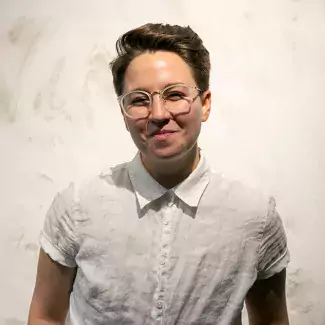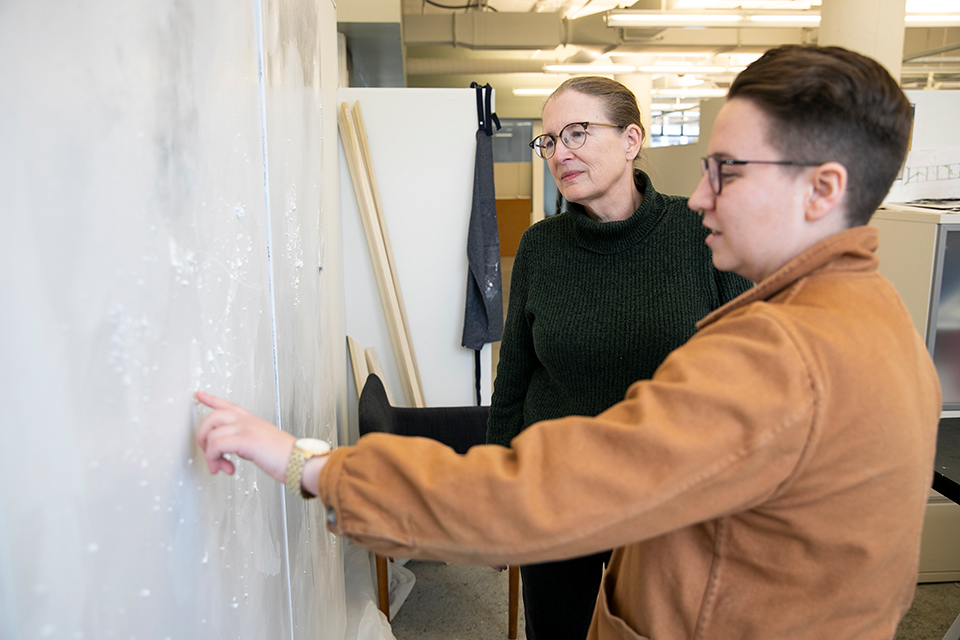
CCAD Stories: Callan Prakel

An MFA candidate finds the space to explore art and identity
Callan Prakel (Master of Fine Arts, 2021) earned their bachelor’s degree from Capital University in art therapy, psychology, and studio art, but at heart, they always knew they were a maker. So, heading to Columbus College of Art & Design for a Master of Fine Art in Visual Arts seemed like the next logical step.
“As I began immersing myself in the Columbus art community, it became evident how influential CCAD is in the community,” Prakel says. “It seemed that every artist out in the city making it happen right now was somehow connected to the school, and I wanted to be part of that moving forward.”
We talked with Prakel about their artistic work, the value of mentor relationships at CCAD, and using their talents to give back to the community.
What are you working on?
I’m working on my first studio project, which consists of five 48-by-60-inch canvas paintings with imagery generated from queer experiences. The first of my series uses a grid system and the stereotypical gender colors, pink and blue, to represent gender binaries and how we don’t all fit into those boxes.
What inspires your work?
Through my background in art therapy, I’d seen people use creating as a means for expression, but I’d only been able to focus on materiality and the techniques of painting. Here at CCAD, I finally feel the space and freedom to explore my identity and how it coexists in my artistic work. I paint in a nonrepresentational style, which allows me to utilize imagery to represent marginalized or unauthorized identities through a highly interpretative and accepted mode of art.
What’s one of your favorite things at CCAD?
That there’s a clear intentionality within the graduate program to develop genuine mentorship.



You had two notable mentors: CCAD President Melanie Corn and Fine Arts Professor Carol Griffith. How did those relationships support your practice?
The mentoring pair of Dr. Corn and Professor Carol Griffith was intentional in that I had two individuals able to give distinct perspectives and expertise instrumental to what I wanted to achieve last semester. With Carol, I received incredible, seasoned guidance, especially specific to painting technique mentoring. It pushed me to develop my eye for even the smallest details impacting my compositions, how I used imagery, and my knowledge of different mediums. My first meeting with her, we sat on the benches in Byers Gallery in front of my first painting in progress, and while looking at my style and application of paint, she gave me the most thorough lesson I’ve ever received on oil paint, the different mediums to combine, and what to expect and look for—all in just thirty minutes. She often shared with me what her own studio practice looks like, and carried a steady, encouraging, and truthful presence and wisdom in our time together.
Dr. Corn, with art history and queer studies expertise, helped me mature the way I conceptually approach my work. At the start of the semester, I felt uncertain about my connection to the content I was exploring in my work. The way she was able to hear my ideas while they were forming and help me work through them conceptually supported how I grew to speak about identity and experience in a nonrepresentational form. Oftentimes, I would have to rewrite my notes from our meetings because I would fill my notebook pages feverishly writing down all the artists, ideas, and readings she suggested I think about. She never blinked an eye at my thought process, knew exactly how to communicate with me to push me in the right direction, and instilled a confidence in me that I hadn’t had before, artistically and personally.
One of my main challenges this semester was contextualizing my understanding of queer theory and moving from working to objectively depict my content to being responsive and emotive. When we all came together, we were able to bounce ideas off of each other to bring a holistic look at my process of painting. While our meetings were for formal mentoring relationships in the MFA program for my first semester, I was fortunate to gain two great relationships that I will continue to appreciate and foster with my time here at CCAD.
It’s unusual for the president of a college or university to play an active role in mentoring. What was it like to work with someone in that position?
I appreciated that someone I admire was investing her time to help me grow as an artist. I was aware of the opportunity it provided and was honored to be a part of her intentionality in being active in the Graduate Studies program. On a daily basis, she oversees so many moving parts of our college, yet every time she came to my studio, I felt nothing but attentiveness, thoughtful critiques and questions, and a connection. One of the first times I met with Dr. Corn, she invited me to her home and had me pull books from her bookshelf to borrow and read throughout the semester, as her shelf was stocked with literature important to my painting series in that semester. That openness felt like she was immediately giving me a part of her experience to be a part of my own learning process.
What’s your impression of CCAD’s faculty and their connection to student success?
What brought me to the MFA program at CCAD was the intentionality in its mentoring structure and the opportunity it gave me to develop connections. Every faculty member I have worked closely with has shown great care, attention, passion for their work and desire to help their students develop and achieve their goals. Through my mentors, graduate assistantship, most recent teaching assistantship, and program’s leadership, I’ve found that as a student, the more you invest in building those ties on campus, the more your faculty will be able to guide and advocate for your success.
What are you passionate about outside the classroom?
I try to give back to my community by volunteering at a church and an anti-human trafficking organization in my neighborhood, Old Towne East.
Why do you like studying fine arts in Columbus?
From CCAD's Saturday Morning Art Classes, the Columbus Museum of Art and Wexner Center for the Arts, Franklinton, Columbus Cultural Arts Center, to small businesses and street art all around Columbus, I believe we are fortunate to have a city that strongly supports artists and encourages creation of all kinds.
What do you do for fun?
Go to the Short North and Clintonville to visit my favorite small businesses, bike around the city or nearby parks, check out fun events in town with friends, play with the decor of my home, read and write at local coffee shops



Learn more about CCAD’s MFA program or apply today.
Learn more about Lydia and their work on Instagram.
Post date
January 16, 2020